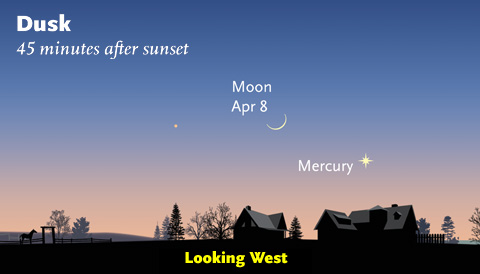Tour April’s Sky: Morning & Evening Planets
This month's astronomy podcast takes you on a guided tour of the night sky. You'll find Mars and Saturn near each other before dawn, while Jupiter and Mercury join the fading constellations of winter in the evening sky after sunset.
April is one of the better months for stargazing. Spring evenings are generally pleasant, and the bugs haven’t taken control — yet! Even with daylight time in effect, evening twilight comes fairly early. You’ll find that the Sun sets between 7:30 and 8:00 p.m. during most of this month, and by 9 p.m. it’s good and dark.
Get up before dawn, and you'll be rewarded with a bright triangle of beacons in the south that's roughly the size of your clenched fist held at arm’s length. The red-supergiant star Antares, marking the heart of Scorpius, is at the bottom of the triangle. To its upper right is Mars, and to its upper left is Saturn.

April provides your best chance all year to spot the elusive, fast-moving planet Mercury low in the west after sunset.
Sky & Telescope diagram
Sky & Telescope diagram
In the evening sky, you’ll be able to spot Mercury low in the west about 45 minutes after sunset. This fast-moving planet has its farthest angular separation from the Sun, what astronomers call greatest elongation, on April 18th. So if you’re never seen Mercury before, this is a good month to look for it. You’ll have a little help on April 8th, when a thin crescent Moon is in the same general area. Mercury is a little less than a fist from the Moon, to its right and a bit lower.
Meanwhile, Jupiter is high in the southeast at nightfall and unmistakably bright. The King of Planets is tangled up in the legs of Leo, the Lion. To Jupiter's upper right is Regulus, the Lion’s brightest star.
No comments:
Post a Comment